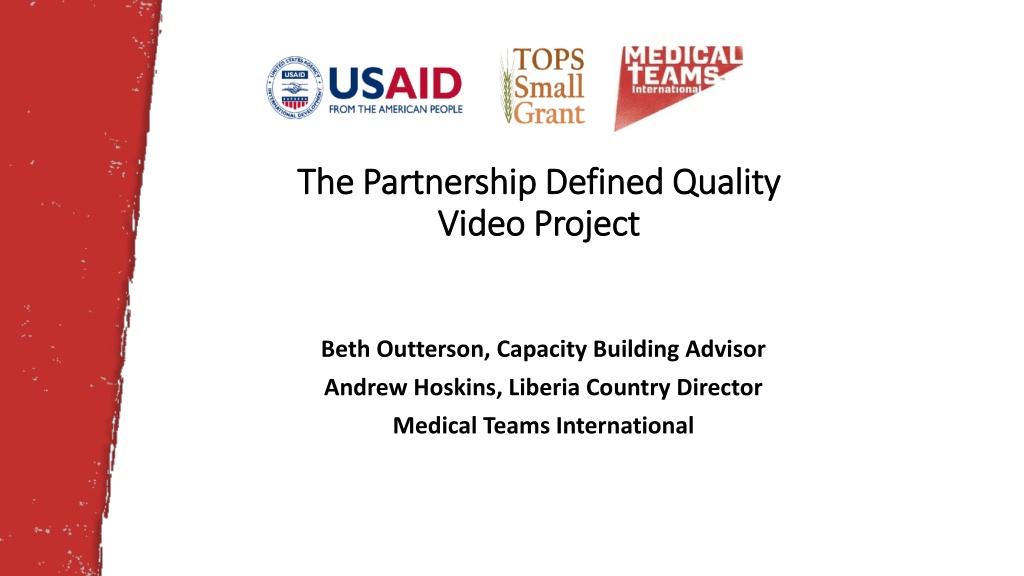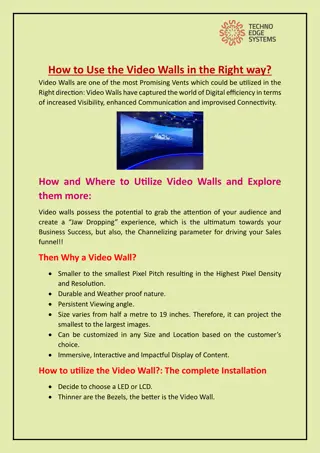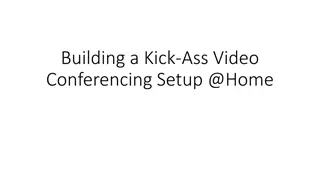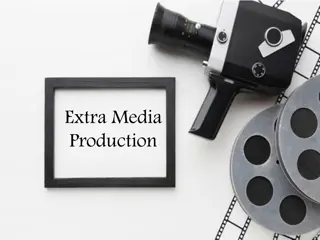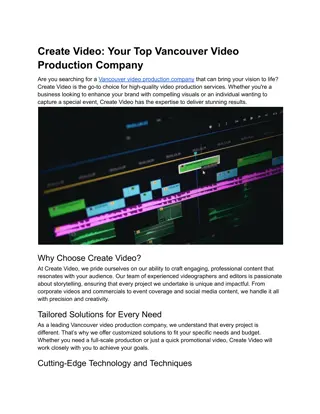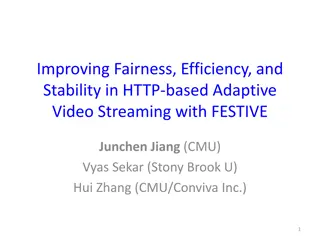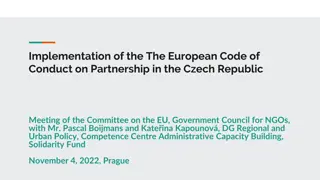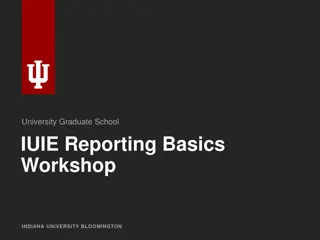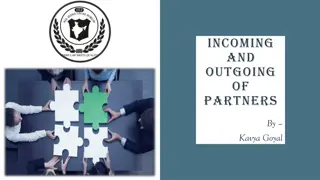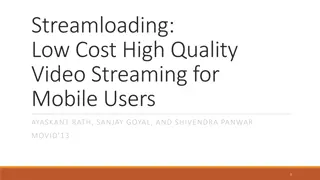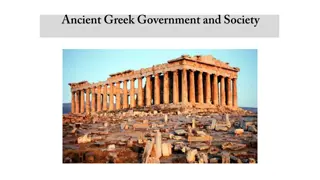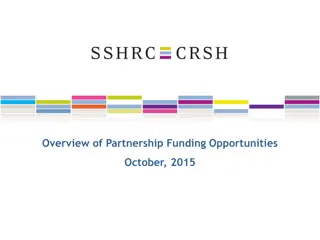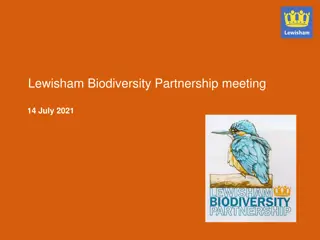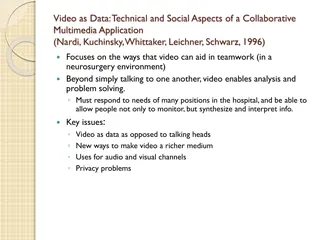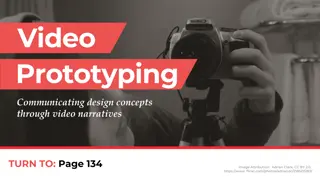Understanding Partnership Defined Quality (PDQ) Video Project
Partnership Defined Quality (PDQ) is a four-phase methodology that enhances service quality by engaging communities in defining, implementing, and monitoring services. The PDQ video project in Liberia aims to raise awareness about this process. It involves storyboarding, filming community scenes, logistics management, editing, and translation. Additionally, a PDQ Video Learning Tool offers FAQs, discussion questions, resources, and a narrative script for further understanding. FAQs address implementation time, equipping low-literacy members for community mobilization, managing QIT after NGO departure, and scaling PDQ.
Uploaded on Oct 04, 2024 | 0 Views
Download Presentation

Please find below an Image/Link to download the presentation.
The content on the website is provided AS IS for your information and personal use only. It may not be sold, licensed, or shared on other websites without obtaining consent from the author. Download presentation by click this link. If you encounter any issues during the download, it is possible that the publisher has removed the file from their server.
E N D
Presentation Transcript
The Partnership Defined Quality The Partnership Defined Quality Video Project Video Project Beth Outterson, Capacity Building Advisor Andrew Hoskins, Liberia Country Director Medical Teams International
Agenda Agenda 1. What is Partnership Defined Quality? 2. Description of PDQ Video Project 3. Discussion of Learning Tool Questions 4. Next Steps 5. Questions
What is Partnership Defined Quality (PDQ)? What is Partnership Defined Quality (PDQ)? Four-phase methodology improves quality and accessibility of services by engaging community members in defining, implementing and monitoring the quality of service delivery. empowers providers and community members to develop solutions together. most often used in health sector. developed by Save the Children implemented in more than 15 countries. Save the Children, 2003
What is the PDQ Video Project? What is the PDQ Video Project? MTI received a TOPS Small Grant to produce a video of the PDQ process it was implementing in Liberia. Purpose: to increase awareness and use of PDQ Process: Storyboarding and draft script Planning with video team for scenes of different phases in 4 communities Manage logistics at community level One week of shooting Narrative finalized Editing and translation The video team shoots QIT meeting in Bambalah
What is the PDQ Video Learning Tool? What is the PDQ Video Learning Tool? A guide that helps to enhance a group s learning about PDQ after viewing the video. The Learning Tool includes: Frequently Asked Questions (FAQs) Discussion Questions PDQ resources Narrative script
Frequently Asked Questions (FAQs) Frequently Asked Questions (FAQs) How long does it take to implement PDQ? How many staff? MTI: Phases 1-3; follow up QIT 3-4 weeks with 1 staff at 100% and 1 staff at 50% and 1 at 25% LOE; QIT follow-up should take 6 months. How can low-literacy QIT members be equipped to mobilize their communities for social change? MTI: pairs of literate/non-literate QIT members conduct exit interviews; create pictorial images to share problems. How will QIT be managed once the implementing NGO departs? MTI staff monitor QITs for 6 months, while training QIT in community mobilization, data collection, leadership, and advocacy. In Liberia, PDQ is endorsed by MOH, so QITs will be integrated into local government structures. How can PDQ be taken to scale, given intensity of work and time needed? This has been an issue in some countries. Depends on minimal sustained funding, and manpower for monitoring and support. More feasible as a component within larger projects, and with prioritization by government. In Liberia, we are experimenting in Sinoe with a schedule of 2 teams each adding one new health facility each month and continuing QIT mentorship.
Discussion Question 1 Discussion Question 1 Have you implemented the PDQ process before in any sector? What are your experiences? Who were the partners in the partnership within your context or in your sector? Focus groups with community members and discussions with providers in Karnga community.
Discussion Question 2 Discussion Question 2 PDQ attempts to address issues and barriers that the community has tried to overcome but has not had success. Most are social barriers that keep people from accessing services. What were some of the barriers mentioned in the video? What other barriers do you see in the communities you work in? Rural road in Grand Cape Mount County
Discussion Question 3 Discussion Question 3 During Phase 2, Exploring Quality, the facilitator starts the focus group discussion with a story about buying cassava in the local market. Much time is spent helping community members think through how they select who they will buy from. Why do you think that understanding the meaning of quality is important? Focus group discussion, Karnga community
Discussion Question 4 Discussion Question 4 PDQ can work in a variety of settings, as long as there are cohesive communities within a catchment area and providers that are responsible to provide a service. PDQ is based on social barriers to services (health, educational agricultural, etc.). used most often where there is strong motivation for change. more difficult where there is NGO saturation, since there may be less willingness to volunteer. What are some country or program contexts where you think PDQ may work well? The Bambalah QIT is building this staff housing next to the health facility. It will also serve as a maternal waiting home.
Discussion Question 5 Discussion Question 5 The PDQ process allows for adaptations to the local culture: In Liberia, exit interviews were conducted by teams of QIT members (one literate, one non-literate) In Pakistan, a different team building game was used since it is not appropriate for men and women to have physical contact. QITs were separate for men and women. What kinds of adaptations do you foresee would be needed to conduct PDQ process in the communities you are working in?
Discussion Question 6 Discussion Question 6 Some standardized tools exist for measuring progress in PDQ. What were the tools mentioned in the video to measure quality improvement? What tools do you know of to measure quality ? What challenges do you face in measuring quality ? Save the Children s PDQ M and E Toolkit
Next Steps for MTI Next Steps for MTI January 20: Haiti launching event with NGO network January 31: Liberia launching event and meetings with development partners and donor agencies Ongoing: Dissemination of Video and Learning Tool through website, social media and conferences. Ongoing: Promotion of PDQ within other country projects
What are your Questions? What are your Questions? The video Partnership Defined Quality: Giving the Community a Voice in Service Delivery and accompanying Learning Tool were made possible by a grant from The Technical and Operational Performance Support (TOPS) Program. The TOPS Micro Grants Program is made possible by the generous support and contribution of the American people through the U.S. Agency for International Development (USAID). The contents of the materials produced through the Micro Grants do not necessarily reflect the views of TOPS, USAID, or the U.S. Government.
